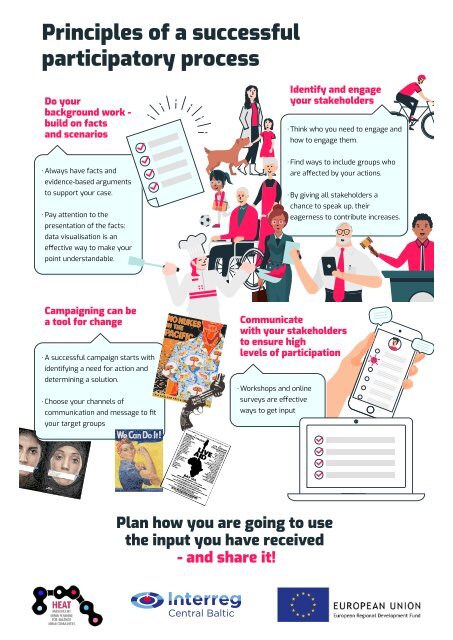Handbook for Participatory Urban Planning
This handbook is a result of an EU-funded project “HEAT - participatory urban planning for healthier urban communities”. For the last two years, the project partners from Finland, Estonia, Latvia and Sweden have worked with more inclusive and participatory processes with a focus on sustainable and healthy communities, particularly related to cycling. Nevertheless, the same principle charts the course, more or less, in any participatory process: you have a goal, and you are trying to find the best available paths to reach it. As the topic is not simple and the change is not happening overnight, we wanted to share our experiences and the knowledge gained during the project with the hope to help or inspire others trying to tackle similar issues.
This handbook is a result of an EU-funded project “HEAT - participatory urban planning for healthier urban communities”. For the last two years, the project partners from Finland, Estonia, Latvia and Sweden have worked with more inclusive and participatory processes with a focus on sustainable and healthy communities, particularly related to cycling. Nevertheless, the same principle charts the course, more or less, in any participatory process: you have a goal, and you are trying to find the best available paths to reach it. As the topic is not simple and the change is not happening overnight, we wanted to share our experiences and the knowledge gained during the project with the hope to help or inspire others trying to tackle similar issues.
You also want an ePaper? Increase the reach of your titles
YUMPU automatically turns print PDFs into web optimized ePapers that Google loves.
Principles of a successful<br />
participatory process<br />
Do your<br />
background work -<br />
build on facts<br />
and scenarios<br />
Identify and engage<br />
your stakeholders<br />
∙Think who you need to engage and<br />
how to engage them.<br />
∙Always have facts and<br />
evidence-based arguments<br />
to support your case.<br />
∙Pay attention to the<br />
presentation of the facts:<br />
data visualisation is an<br />
effective way to make your<br />
point understandable.<br />
∙Find ways to include groups who<br />
are affected by your actions.<br />
∙By giving all stakeholders a<br />
chance to speak up, their<br />
eagerness to contribute increases.<br />
Campaigning can be<br />
a tool <strong>for</strong> change<br />
∙A successful campaign starts with<br />
identifying a need <strong>for</strong> action and<br />
determining a solution.<br />
∙Choose your channels of<br />
communication and message to fit<br />
your target groups<br />
Communicate<br />
with your stakeholders<br />
to ensure high<br />
levels of participation<br />
∙Workshops and online<br />
surveys are effective<br />
ways to get input<br />
Plan how you are going to use<br />
the input you have received<br />
- and share it!<br />
47<br />
Do your background work - build on facts and scenarios
















